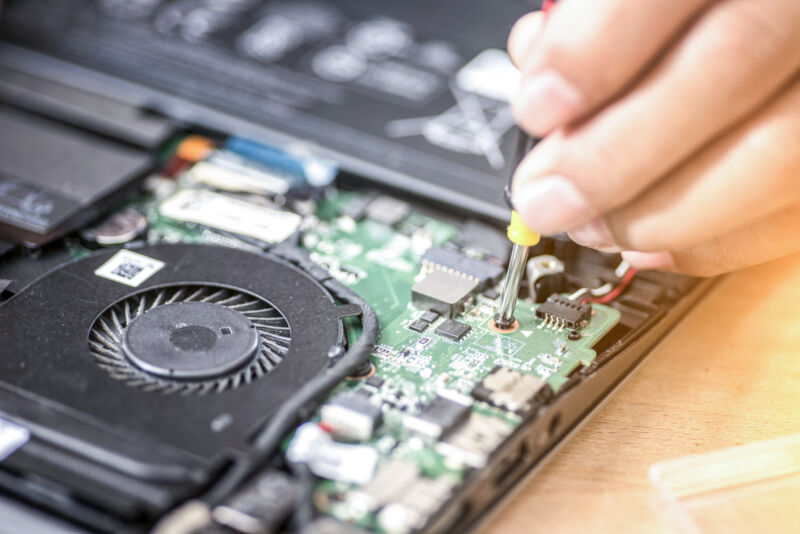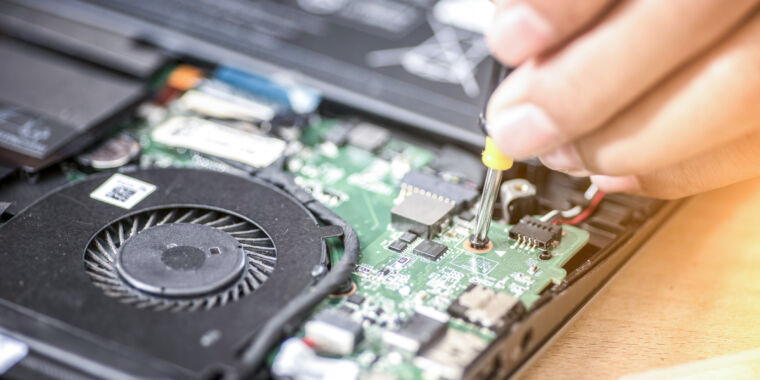
The fight for the right to repair scored a huge win Friday with New York state passing a bill that requires digital electronics manufacturers, like laptop and smartphone manufacturers, to make diagnostic and repair information available to consumers and independent repair shops.
The bill, which passed in the New York Senate (49 to 14) on Wednesday and in the Assembly (145 to 1) today, enacts the Digital Fair Repair Act. Governor Kathy Hochul has to sign the bill before it is law, but advocates, like iFixit, said they don’t expect obstacles there.
Notably, the bill doesn’t pertain to medical devices, home appliances, agricultural and off-road equipment, or public safety communications equipment. However, right-to-repair advocates have their eye on those areas as well. The bill also doesn’t cover motor vehicles.
Companies selling tech products in New York that are covered will be obligated to distribute information, software, tools, and parts so that individuals and independent repair shops can repair personal devices on their own. iFixit said it expects this to take effect by 2023.
More specifically, the bill says it:
“Requires OEMs to make available, for purposes of diagnosis, maintenance, or repair, to any independent repair provider, or to the owner of digital electronic equipment manufactured by or on behalf of, or sold by, the OEM, on fair and reasonable terms, documentation, parts, and tools, inclusive of any updates to information. Nothing in this section requires an OEM to make available a part if the part is no longer available to the OEM. For equipment that contains an electronic security lock or other security-related function, the OEM shall make available to the owner and to independent repair providers, on fair and reasonable terms, any special documentation, tools, and parts needed to access and reset the lock or function when disabled in the course of diagnosis, maintenance, or repair of the equipment. Such documentation, tools, and parts may be made available through appropriate secure release systems.”
Fighting “monopolistic practices”
The bill successfully argued that it will help protect against “monopolistic practices of digital electronics manufacturers,” brought on by the withholding of repair and diagnostic information. This forced consumers to rely on product manufacturers and their authorized repair providers. According to a blog post by iFixit CEO Kyle Wiens today, 59 percent of independent repair shops in California recently reported fear of closure without the right to repair.
“Nothing prevents third-party repairers from being technically competent to complete digital repairs other than the lack of information being withheld by manufacturers,” the bill states. “In too many instances, repairs of digital items are intentionally limited by the manufacturer.”
The bill also points to “inflated, high repair prices, poor service or non-existent service in rural areas, and unnecessarily high turnover rates for electronic products” as justification for the legislation.
E-waste was also a driver for the bill, as well as the general fight for the right to repair. In a statement, New York Assemblymember Patricia Fahy said the bill would “help to reduce the 655,000 tons of toxic e-waste produced [and] typically discarded in a single calendar year here in New York state.”
In its announcement, the New York State Assembly pointed to a study by the US Public Interest Group finding that the average New York family would save approximately $330 per year and reduce electronic waste by 22 percent with the right to repair.
Beyond the Empire State
While right-to-repair advocates scored a notable win, there’s much more legislation required before the right extends across the country and product categories.
In his blog Friday, iFixit’s Wiens pointed to the impact the passing of the law is expected to have around the world. For one, the exec hopes that manufacturers will make repair manuals open to everyone, not just New Yorkers.
Wiens also expressed hope for software protections catching on outside of New York.
“The New York law includes provisions for resetting the software locks that some manufacturers use to tie parts to the device’s motherboard or serial number. Manufacturers will have to find some way to make parts pairing reset tools available to the public. That’s a huge boon for repair, but it also helps the refurbishment industry: Lots of refurbishers harvest parts from old devices, which is impossible when those devices have parts paired to the motherboard,” Wiens said, noting related infrastructure challenges facing vendors.
Ars recently spoke with Wiens, who discussed the biggest challenges and happenings in the fight for the right to repair, including the necessity of federal involvement. You can check out our interview on the right to repair with iFixit’s CEO here.








